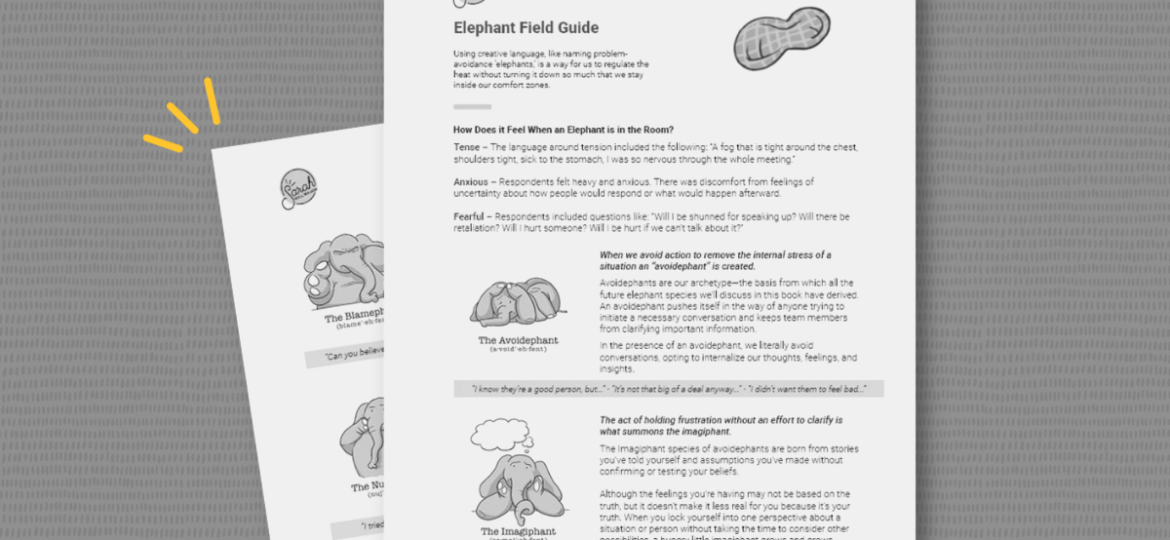
Using creative language, like naming problem-avoidance ‘elephants,’ is a way for us to regulate the heat without turning it down so much that we stay inside our comfort zones.
How Does it Feel When an Elephant is in the Room?
- Tense – The language around tension included the following: “A fog that is tight around the chest, shoulders tight, sick to the stomach, I was so nervous through the whole meeting.”
- Anxious – Respondents felt heavy and anxious. There was discomfort from feelings of uncertainty about how people would respond or what would happen afterward.
- Fearful – Respondents included questions like: “Will I be shunned for speaking up? Will there be retaliation? Will I hurt someone? Will I be hurt if we can’t talk about it?”
When Avoidance is the Elephant in the Room
When we avoid action to remove the internal stress of a situation an “avoidephant” is created.
Avoidephants are our archetype—the basis from which all the future elephant species we’ll discuss in this book have derived. An avoidephant pushes itself in the way of anyone trying to initiate a necessary conversation and keeps team members from clarifying important information.
In the presence of an avoidephant, we literally avoid conversations, opting to internalize our thoughts, feelings, and insights.
When Imaginary Scenarios Create an Elephant in the Room
The act of holding frustration without an effort to clarify is what summons the imagiphant.
The Imagiphant species of avoidephants are born from stories you’ve told yourself and assumptions you’ve made without confirming or testing your beliefs.
Although the feelings you’re having may not be based on the truth, but it doesn’t make it less real for you because it’s your truth. When you lock yourself into one perspective about a situation or person without taking the time to consider other possibilities, a hungry little imagiphant grows and grows.
Blame Creates a Big Elephant in the Room
When we complain instead of acting on problems, there’s a good chance we have a blamephant in the room.
One of the most common ways to feed a blamephant—another pesky species of avoidephant—in a team is to blame the leader.
At some point, we’ve all been in a situation where we know there’s a barrier, and instead of acting, we blame other people’s inaction for that barrier.
Dancing Around an Issue is a Smaller, but Still Damaging Elephant in the Room
We feed a nudgephant when we see a barrier, and instead of addressing the issue directly, we try to nudge our team forward with indirect effort.
We sugarcoat our words or drop hints instead of making statements. When we’re dealing with a nudgephant, it means we’ve worked up a little bit of courage to approach an issue, but it might not be enough.
If you and your team are dancing around an issue without diving in to address it, you may have a nudgephant in the room.
Deflecting Creates Comfort in the Short-Term, but an Elephant in the Room Long-Term
A deflectephant gets a handful of peanuts whenever someone makes a joke, or displays sarcastic, self-deprecating behavior or attempts to create a detour in response to an uncomfortable situation.
When a situation gets uncomfortable, the deflectephant likes to whisper in the ear of the office jokester or quickly shifting topics.
The deflectephant aids diversion. When someone is unwilling to be vulnerable, they may attempt to minimize or hide their own discomfort by creating discomfort in other people or creating a distraction.
Download Your Free Elephants Field Guide
Never miss an elephant in the room again! Download your free digital field guide to identifying elephants at work (and in your personal life). Download your guide and start seeing elephants everywhere.
Sarah Noll Wilson is on a mission to help leaders build and rebuild teams. She aims to empower leaders to understand and honor the beautiful complexity of the humans they serve. Through her work as an Executive Coach, an in-demand Keynote Speaker, Researcher, Contributor to Harvard Business Review, and Bestselling Author of “Don’t Feed the Elephants”, Sarah helps leaders close the gap between what they intend to do and the actual impact they make. She hosts the podcast “Conversations on Conversations”, is certified in Co-Active Coaching and Conversational Intelligence, and is a frequent guest lecturer at universities. In addition to her work with organizations, Sarah is a passionate advocate for mental health.


